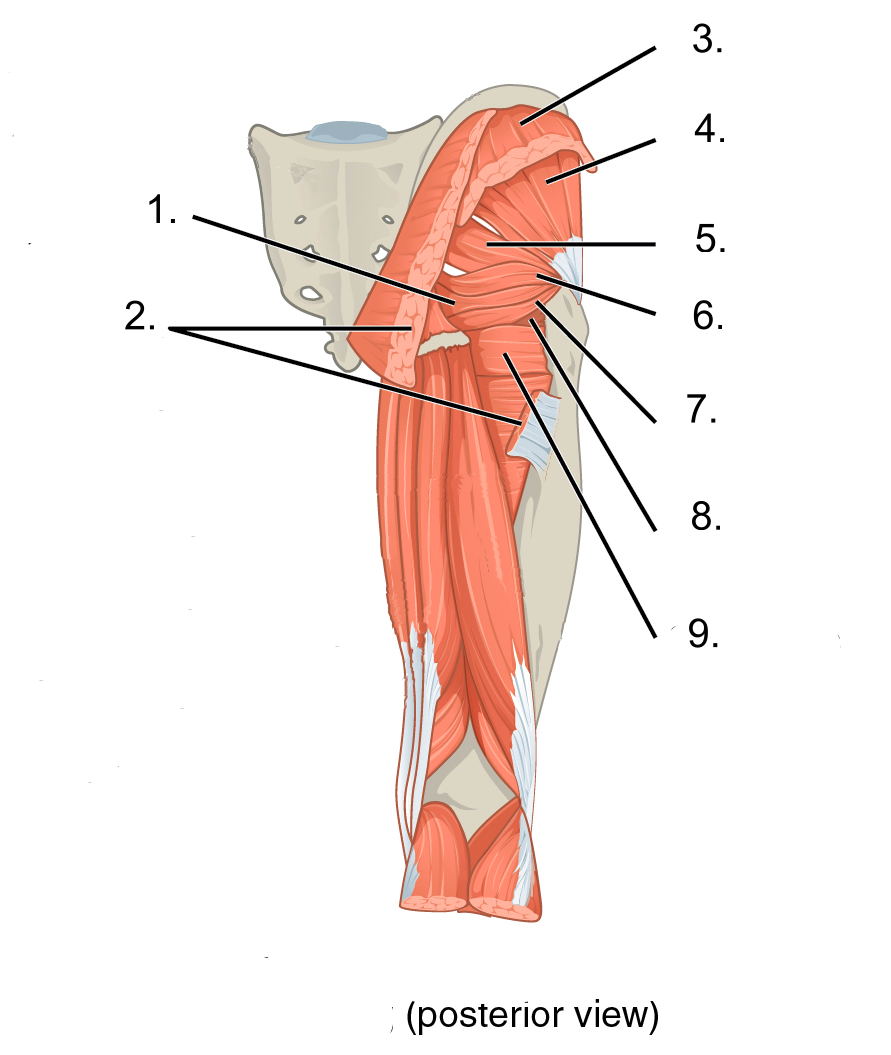Pelvis
Chapter Conclusion
Learning Objectives
- Understand features of the ischium, pubis, and ilium that form the 2 coxal bone. This includes anatomical feature, differences among gender, and function.
- Be able to fully describe the origin, insertion, action, and nerve innervation of the 4 gluteal muscles and the 6 lateral rotator muscles. Also be able to describe there relative position with one another.
- Identify the main muscles that make up the pelvic floor and their function.
- Understand the features of the hip joint and the main ligaments associated with pelvis.
- Identify the major blood vessels in this region and what areas these vessels drain/supply blood to.
- Develop a general understanding of the major clinical conditions in this area.
Part A.
1. The ischium, pubis, and ilium meet at the?
a) obturator foramen
b) acetabulum
c) fovea capitas
d) apex
2. The pelvic girdle is composed of?
a) 2 coxal bones
b) 2 coxal bones, sacrum
c) 2 coxal bones, sacrum, coccyx
d) 2 coxal bones, sacrum, coccyx, 2 femurs
3. The __________ separates the __________________ & the __________________.
a) ischial tuberosity, greater sciatic notch, lesser sciatic notch
b) ischial tuberosity, superior pubic ramus, inferior pubic ramus
c) ischial spine, greater sciatic notch, lesser sciatic notch
d) ischial spine, superior pubic ramus, inferior pubic ramus
4. Which of the following statements is false when comparing males to females?
a) Males have a thicker and heavier pelvis compared to females.
b) Males have a larger pelvis compared to females
c) Males have a more pronounced sacral curve anteriorly compared to females
d) Males have a smaller pubic angle compared to females.
5. What is the action(s) of gluteus maximus?
a) hip extension
b) hip extension & lateral rotation
c) hip extension, lateral rotation, and abduction
d) none of the above
6. Which of the following statements is false regarding the gluteus medius and minimus muscles?
a) both cause hip abduction and medial rotation
b) both inset on the greater trochanter
c) both are innervated by the inferior gluteal nerve
d) all of the above are correct
7. Which is the following ligaments does not help in the reinforcement of the hip joint?
a) iliofemoral ligament
b) ishiofemoral ligament
c) pubofemoral ligament
d) all of the ligaments above help in reinforcing the hip joint
8. Which of the following statements is true regarding the 6 lateral rotators of the hip?
a) they all insert on the lesser trochanter
b) they are all very superficial
c) they all help stabilize the hip joint
d) all of the above are correct
9. The pelvis floor has _____ main important functions. (hint: they all start with S)
a) 1
b) 3
c) 5
d) 7
10. Which is the following muscles is of clinical importance due to its interaction with the sciatic nerve?
a) piriformis
b) quadratus femoris
c) superior gemellus
d) inferior gemellus
Part B.
Following the following questions, circle T if the statement is true, and F if the statement is false.
- The pelvis girdle is more mobile than the pectoral girdle. T / F
- That part of the pelvis that is contact with a chair while in a seated position is the ischial tuberosity. T / F
- The gluteus maximus muscle is innervated by the superior gluteal nerve. T / F
- The two primary ligaments of the gluteal region are the sacrotuberous ligament and the sacrospinous ligament. T / F
- The point of contact between the coxal bone and sacrum is the auricular surface. T / F
- The IT band extends from the AIIS to the lateral condyle of the tibia. T / F
- The major arteries that supply gluteal region are the superior and inferior gluteal artery. T / F
- The left and right common iliac artery furthur divides into the superior and inferior iliac artery. T / F
- The sciatic nerve is important because it innervates most of the lateral rotator muscles. T / F
- The pelvis consists of 2 coxal bones, sacrum, coccyx. T / F
Part C.
Correctly identify the components in the following diagrams. All of the definitions will be used once.
| Questions | Definitions |
| 1.
2. 3. 4. 5. 6. 7. 8. 9.
|
A. piriformis
B. gluteus maximus C. quadratus femoris D. obturator externus E. inferior gemellus F. gluteus medius G. obturator internus H. gluteus minimus I. superior gemellus
|
Answer key
Part A.
- b 2. a 3. c 4. b 5. b 6. c 7. d 8. c 9. c 10. a
Part B.
- F 2. T 3. F 4. T 5. T 6. F 7. T 8. F 9. F 10. T
Part C.
- G 2. B 3. F 4. H 5. A 6. I 7. E 8. D 9. C

